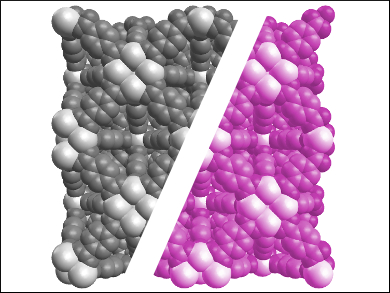Alkanes are not easy to detect with simple, inexpensive methods, such as colorimetric changes, due to their lack of functional groups. However, they are widely used and a method of detecting them with the naked eye could be useful.
Yohei Takashima, Kensuke Akamatsu, and colleagues, Konan University, Kobe, Japan, have developed a simple system that can recognize alkanes and changes its color from white to pink in their presence. The team synthesized two types of the metal-organic framework (MOF) UiO-66, which contains Zr6O4(OH)4 and 1,4-benzenedicarboxylate: one under typical conditions and one with the addition of hypochloric acid, which introduces defects into the framework.
The MOF was combined with 7-azaindole, which can coordinate to defect sites in the framework’s pores, where it forms a charge-transfer complex with zirconium and causes a change in light absorption. 7-azaindole strongly interacts with polar solvents and remains in solution. However, in hydrophobic solvents such as alkanes, it enters the MOF’s pores and coordinates to defect sites, leading to a detectable color change. This mechanism was corroborated by the fact that the colorimetric change is stronger in the UiO-66 sample with a higher number of defect sites. According to the researchers, this system could be especially interesting for monitoring the leakage of alkanes in petroleum plants.
- Unusual Colorimetric Change for Alkane Solvents with a Porous Coordination Framework,
Yohei Takashima, Yasushi Sato, Takaaki Tsuruoka, Kensuke Akamatsu,
Inorg. Chem. 2016.
DOI: 10.1021/acs.inorgchem.6b01754




